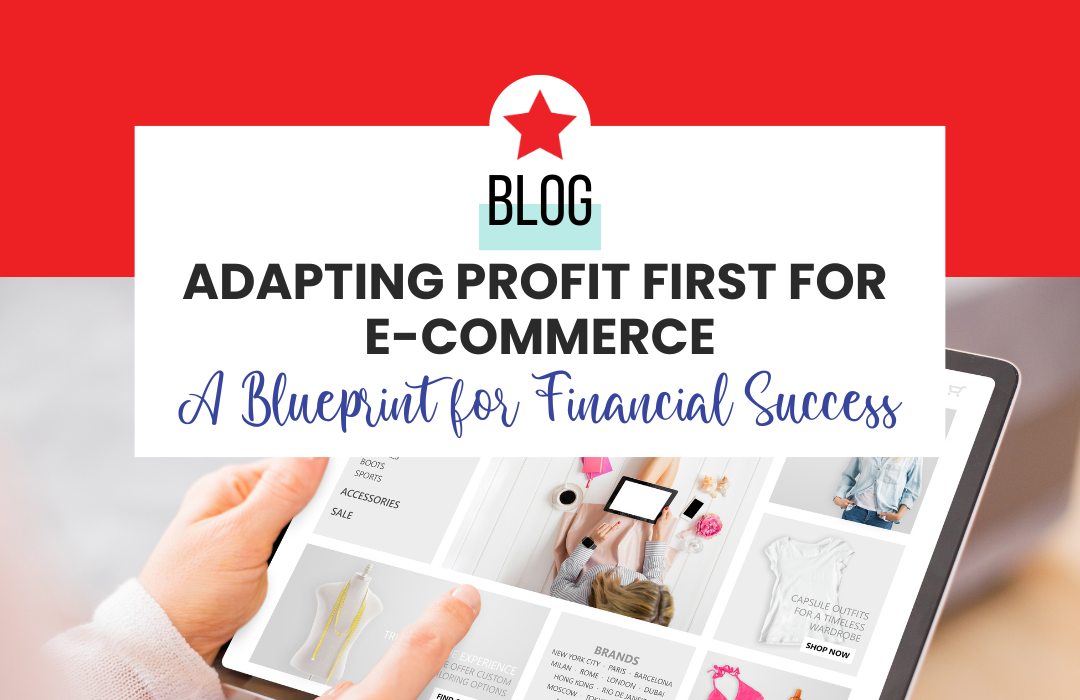[et_pb_section fb_built=”1″ _builder_version=”4.13.0″ _module_preset=”default” global_colors_info=”{}”][et_pb_row _builder_version=”4.13.0″ _module_preset=”default” global_colors_info=”{}”][et_pb_column type=”4_4″ _builder_version=”4.13.0″ _module_preset=”default” global_colors_info=”{}”][et_pb_text admin_label=”Text” _builder_version=”4.13.0″ _module_preset=”default” global_colors_info=”{}”]
Running an e-commerce business is challenging, especially when it comes to managing finances. The Profit First method, created by Mike Michalowicz, offers a unique approach to ensure profitability by prioritizing profit in financial management. While it was originally designed for traditional businesses, it can be adapted to suit the unique needs of e-commerce ventures.
E-commerce businesses face specific financial challenges such as fluctuating revenue, high inventory costs, and varied cash flow cycles. This post explores how to adapt Profit First for e-commerce, helping you maintain profitability in your online business.
Understanding the Profit First System
Profit First flips traditional accounting by prioritizing profit. Instead of calculating profit as what’s left after expenses, you distribute a percentage of revenue to profit first, followed by owner’s pay, taxes, and operating expenses.
Key Principles of Profit First:
- Profit first: Allocate a set percentage of income to profit before expenses.
- Separate accounts: Use multiple bank accounts to distribute funds into profit, owner’s pay, taxes, and operating expenses.
- Smaller plates: By limiting funds for expenses, you’re forced to manage the business more efficiently.
This system ensures profitability, fair compensation for the owner, and coverage of taxes. However, it requires specific adjustments to work effectively in an e-commerce setting.
Adapting Profit First for E-commerce
E-commerce businesses have unique cash flow patterns due to fluctuating sales and high inventory costs. To implement Profit First effectively, you must adjust the system to align with these patterns.
Cash Flow Management
E-commerce cash flow can be volatile, requiring a tailored approach to Profit First.
- Establish a Reserve Account: Create a separate account to cover slow sales periods or unexpected expenses, stabilizing your cash flow.
- Adjust Allocation Percentages: Adjust Profit First percentages to suit your business model, particularly during high inventory turnover periods.
- Monitor Regularly: E-commerce sales can be unpredictable, so adjust allocations weekly or bi-weekly to match revenue cycles.
These strategies help support financial stability in the face of fluctuating sales, connecting your cash flow management directly to Profit First principles.
Refining Inventory Management
Inventory is often the largest expense for e-commerce businesses. Mismanagement can lead to cash flow issues or excess stock. Adapting Profit First can help you improve inventory spending.
Steps to Optimize Inventory Using Profit First:
- Separate Inventory Funds: Create a dedicated account for inventory purchases to avoid overspending.
- Plan for Seasonality: Use your reserve account to buy inventory in bulk during off-peak seasons, reducing costs and preparing for high-demand periods.
- Negotiate Payment Terms: Work with suppliers to get favorable payment terms, helping you manage cash flow while supporting Profit First allocations.
By linking inventory management to Profit First, you keep a balance between having enough stock and staying profitable.
Pricing Strategy Adjustments
Pricing impacts revenue and Profit First allocations. Adjusting your pricing strategy can support the system’s effectiveness in an e-commerce setting.
Consider These Adjustments:
- Incorporate Profit Margins: Ensure your pricing allows sufficient allocation to profit without compromising quality or service.
- Dynamic Pricing: Implement dynamic pricing to maximize revenue during peak periods, increasing Profit First allocations.
- Bundle Products: Create bundles to increase the average order value, allowing for higher profit allocations.
These adjustments align your pricing with Profit First, ensuring that each sale supports your overall profitability.
Leveraging Technology to Simplify Profit First
Technology can simplify implementing Profit First in e-commerce by automating financial tracking, budgeting, and allocation processes.
Tech Tools to Consider:
- Accounting Software Integration: Use software that integrates with your e-commerce platform to automate Profit First allocations.
- Cash Flow Management Apps: Tools like Float can predict cash flow trends, helping adjust Profit First allocations.
- Inventory Management Systems: Implement software that tracks stock levels and sales patterns, aligning inventory purchases with your Profit First strategy.
These tools streamline the Profit First process, making it easier to maintain profitability while focusing on business growth.
Ensuring Consistency and Discipline
Maintaining consistency and discipline is crucial for the long-term success of Profit First. E-commerce entrepreneurs must avoid the temptation to dip into profit allocations.
Strategies to Maintain Discipline:
- Automate Transfers: Set up automatic transfers to your profit, tax, and owner’s pay accounts to ensure consistent allocations.
- Set Boundaries for Operating Expenses: Clearly define what qualifies as an operating expense to protect Profit First allocations.
- Review Quarterly: Regularly review and adjust Profit First allocations to align with your business’s evolving needs.
By adhering to these strategies, you protect the integrity of Profit First and ensure ongoing profitability.
Adapting the Profit First system for e-commerce requires careful planning, flexibility, and discipline. By customizing allocation percentages, refining inventory management, using technology, and maintaining consistency, you can achieve financial stability and growth in your online business. Profit First isn’t just about making your business profitable—it’s about empowering you to take control of your finances and build a thriving e-commerce venture.
[/et_pb_text][/et_pb_column][/et_pb_row][et_pb_row _builder_version=”4.13.0″ _module_preset=”default” global_colors_info=”{}”][et_pb_column type=”4_4″ _builder_version=”4.13.0″ _module_preset=”default” global_colors_info=”{}”][et_pb_code _builder_version=”4.13.0″ _module_preset=”default” global_colors_info=”{}”]
[/et_pb_code][/et_pb_column][/et_pb_row][et_pb_row _builder_version=”4.13.0″ _module_preset=”default” global_colors_info=”{}”][et_pb_column type=”4_4″ _builder_version=”4.13.0″ _module_preset=”default” global_colors_info=”{}”][et_pb_post_slider include_categories=”current” _builder_version=”4.13.0″ _module_preset=”default” global_colors_info=”{}”][/et_pb_post_slider][/et_pb_column][/et_pb_row][et_pb_row column_structure=”1_2,1_2″ _builder_version=”4.13.0″ _module_preset=”default” global_colors_info=”{}”][et_pb_column type=”1_2″ _builder_version=”4.13.0″ _module_preset=”default” global_colors_info=”{}”][et_pb_image src=”https://sparkbusinessconsulting.com/wp-content/uploads/2024/09/Sept-Blog-Template-.png” title_text=”Sept Blog Template” _builder_version=”4.13.0″ _module_preset=”default” global_colors_info=”{}”][/et_pb_image][/et_pb_column][et_pb_column type=”1_2″ _builder_version=”4.13.0″ _module_preset=”default” global_colors_info=”{}”][et_pb_image src=”https://sparkbusinessconsulting.com/wp-content/uploads/2024/09/Copy-of-Copy-of-PIN-Quote-White.png” title_text=”Copy of Copy of PIN Quote-White” _builder_version=”4.13.0″ _module_preset=”default” global_colors_info=”{}”][/et_pb_image][/et_pb_column][/et_pb_row][/et_pb_section][et_pb_section fb_built=”1″ _builder_version=”4.13.0″ _module_preset=”default” global_colors_info=”{}”][/et_pb_section]









